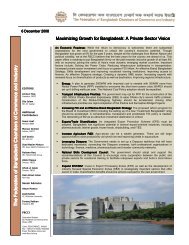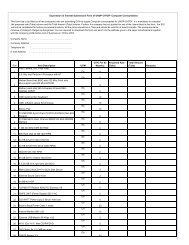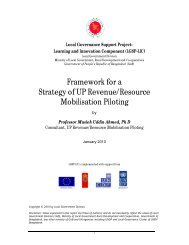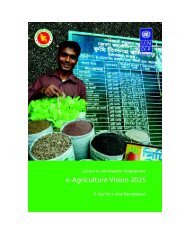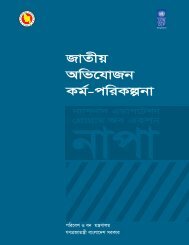The probable impacts of climate change on poverty - UNDP
The probable impacts of climate change on poverty - UNDP
The probable impacts of climate change on poverty - UNDP
Create successful ePaper yourself
Turn your PDF publications into a flip-book with our unique Google optimized e-Paper software.
Table 6.9 Percepti<strong>on</strong> <str<strong>on</strong>g>of</str<strong>on</strong>g> Present Level <str<strong>on</strong>g>of</str<strong>on</strong>g> Impacts related to Climate Change in the Coastal Areas<br />
Major Changes and Impacts<br />
Crop loss/Yield<br />
reducti<strong>on</strong> (%)<br />
Soil salinitywill be increased with extent and severity 20<br />
Swelling/heavy clays/salt crusting in land preparati<strong>on</strong><br />
Degradati<strong>on</strong> <str<strong>on</strong>g>of</str<strong>on</strong>g> soil physical/chemical properties due to prol<strong>on</strong>ged water<br />
10<br />
stagnancy creating micro-nutrient deficiencies <str<strong>on</strong>g>of</str<strong>on</strong>g> S and Znwetland rice<br />
cultivati<strong>on</strong>.<br />
20<br />
Increasing soil-related c<strong>on</strong>straints (viz.swelling/cracking clays, soilwetness)<br />
that create problems in land preparati<strong>on</strong><br />
Late planting <str<strong>on</strong>g>of</str<strong>on</strong>g> rabi crops due to delaying in recessi<strong>on</strong> <str<strong>on</strong>g>of</str<strong>on</strong>g> flood water<br />
and soil wetness<br />
Damage <str<strong>on</strong>g>of</str<strong>on</strong>g> standing crops (khesari, soybean, groundnut) due to moisture<br />
stress and salinity<br />
20<br />
Increasing water-logged areas keeping more cultivable land as fallow in Rabi,<br />
Kharif-I and Kharif-II seas<strong>on</strong><br />
Fallow:50%<br />
Changes in crops/cropping pattern with varieties 10 (increase)<br />
Rainfed aus crop will be affected bydrought and salinity 20<br />
Boro and wheat will be affected by salinity 20<br />
C<strong>on</strong>versi<strong>on</strong> <str<strong>on</strong>g>of</str<strong>on</strong>g> crop land into shrimp culture 30<br />
Increasing incidences <str<strong>on</strong>g>of</str<strong>on</strong>g> pests and diseases<br />
Decreasing income source <str<strong>on</strong>g>of</str<strong>on</strong>g> the poor in coastal areas<br />
20<br />
6.2.3 Future Impacts – Model Result<br />
Various studies indicate that a temperature rise <str<strong>on</strong>g>of</str<strong>on</strong>g> 1 to 20C in combinati<strong>on</strong> with lower solar radiati<strong>on</strong> causes<br />
sterility in rice spikelets. High temperature was found to reduce yields <str<strong>on</strong>g>of</str<strong>on</strong>g> HYVs <str<strong>on</strong>g>of</str<strong>on</strong>g> aus, aman and boro rice in all<br />
study locati<strong>on</strong>s and in all seas<strong>on</strong>s. <str<strong>on</strong>g>The</str<strong>on</strong>g> effect was particularly evident at a rise <str<strong>on</strong>g>of</str<strong>on</strong>g> temperature by 40C. Climate<br />
<str<strong>on</strong>g>change</str<strong>on</strong>g>s, especially in temperature, humidity and radiati<strong>on</strong>, have great effects <strong>on</strong> the incidence <str<strong>on</strong>g>of</str<strong>on</strong>g> insect pests,<br />
diseases and microorganisms. A <str<strong>on</strong>g>change</str<strong>on</strong>g> <str<strong>on</strong>g>of</str<strong>on</strong>g> 10C <str<strong>on</strong>g>change</str<strong>on</strong>g>s the virulence <str<strong>on</strong>g>of</str<strong>on</strong>g> some races <str<strong>on</strong>g>of</str<strong>on</strong>g> rust infecting wheat.<br />
<str<strong>on</strong>g>The</str<strong>on</strong>g> producti<strong>on</strong> <str<strong>on</strong>g>of</str<strong>on</strong>g> crop in Bangladesh is c<strong>on</strong>strained by too much water during the wet seas<strong>on</strong> and too little<br />
during the dry seas<strong>on</strong>. Presently total irrigated area is 4.4 milli<strong>on</strong> ha which is more than 50 % <str<strong>on</strong>g>of</str<strong>on</strong>g> the potentially<br />
irrigable area <str<strong>on</strong>g>of</str<strong>on</strong>g> 7.12 milli<strong>on</strong> ha cultivated area. This area is being irrigated through surface and ground water.<br />
Irrigati<strong>on</strong> coverage through Shallow tubewells (STWs) during the dry period has grown very fast following a<br />
policy <str<strong>on</strong>g>of</str<strong>on</strong>g> privatizati<strong>on</strong> and deregulati<strong>on</strong>. As a result, the groundwater table in Bangladesh is declining at a rapid<br />
rate causing STWs to become n<strong>on</strong>-operati<strong>on</strong>al in many parts <str<strong>on</strong>g>of</str<strong>on</strong>g> the country during dry period. Lack <str<strong>on</strong>g>of</str<strong>on</strong>g> surface<br />
water during the dry seas<strong>on</strong> limits the functi<strong>on</strong> <str<strong>on</strong>g>of</str<strong>on</strong>g> Low Lift Pumps.<br />
<str<strong>on</strong>g>The</str<strong>on</strong>g> GFDL model predicted about 17 % decline in overall rice producti<strong>on</strong> and as high as 61 per cent decline in<br />
wheat producti<strong>on</strong> compared to the baseline situati<strong>on</strong> <str<strong>on</strong>g>of</str<strong>on</strong>g> 1990 under 4 degree <str<strong>on</strong>g>change</str<strong>on</strong>g>s in temperature. <str<strong>on</strong>g>The</str<strong>on</strong>g><br />
highest impact would be <strong>on</strong> wheat followed by rice (aus variety). This translates to a reducti<strong>on</strong> <str<strong>on</strong>g>of</str<strong>on</strong>g> 4.5 milli<strong>on</strong> t<strong>on</strong>s<br />
<str<strong>on</strong>g>of</str<strong>on</strong>g> rice at the present level (2002) <str<strong>on</strong>g>of</str<strong>on</strong>g> producti<strong>on</strong>. Of the three varieties <str<strong>on</strong>g>of</str<strong>on</strong>g> rice grown in Bangladesh, the aus rice<br />
(grown during the summer, m<strong>on</strong>so<strong>on</strong> period under rain-fed c<strong>on</strong>diti<strong>on</strong>s) seems to be the most vulnerable. <str<strong>on</strong>g>The</str<strong>on</strong>g><br />
other model, Canadian Climate Change Model (CCCM) predicted a significant fall in food-grain producti<strong>on</strong>. It<br />
should be noted, however, that this scenario was based <strong>on</strong> projecting existing cropping patterns into the futurewhich<br />
is not necessarily what will happen, as there are signs <str<strong>on</strong>g>of</str<strong>on</strong>g> significant <str<strong>on</strong>g>change</str<strong>on</strong>g>s already taking place in<br />
cropping patterns.<br />
It was noticed that temperature increase <str<strong>on</strong>g>of</str<strong>on</strong>g> 4 o C would have severe impact <strong>on</strong> food-grain producti<strong>on</strong>, especially<br />
for wheat producti<strong>on</strong>. On the other hand, carb<strong>on</strong>-dioxide fertilizati<strong>on</strong> would facilitate food-grain producti<strong>on</strong>. A<br />
rise in temperature would cause significant decrease in producti<strong>on</strong> <str<strong>on</strong>g>of</str<strong>on</strong>g> 28 % and 68 % for rice and wheat<br />
respectively. Moreover, doubling <str<strong>on</strong>g>of</str<strong>on</strong>g> atmospheric c<strong>on</strong>centrati<strong>on</strong> <str<strong>on</strong>g>of</str<strong>on</strong>g> CO2 in combinati<strong>on</strong> with a similar rise in<br />
temperature would result in an overall 20 % rise in rice producti<strong>on</strong> and 31 % decline in wheat producti<strong>on</strong>. It was<br />
<str<strong>on</strong>g>The</str<strong>on</strong>g> Probable Impacts <str<strong>on</strong>g>of</str<strong>on</strong>g> Climate Change <strong>on</strong> Poverty and Ec<strong>on</strong>omic Growth and<br />
the Opti<strong>on</strong>s <str<strong>on</strong>g>of</str<strong>on</strong>g> Coping with adverse Effect <str<strong>on</strong>g>of</str<strong>on</strong>g> Climate Change in Bangladesh<br />
20<br />
20<br />
47




